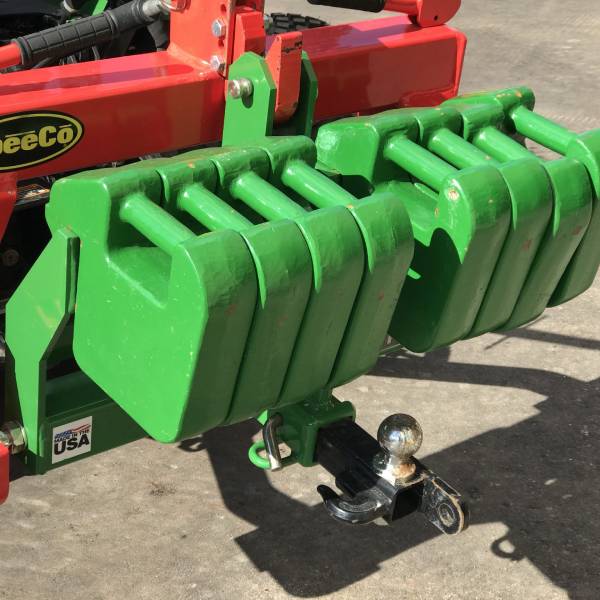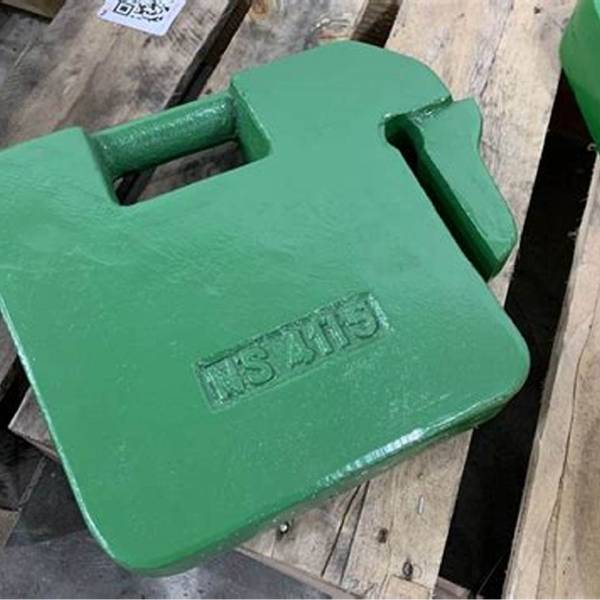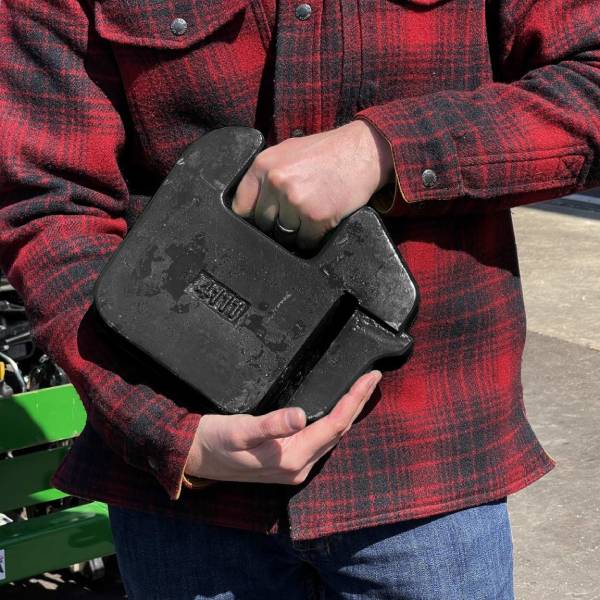What Are John Deere Suitcase Weights?
John Deere suitcase weights are removable cast iron weights. They attach to the front or back of your tractor. Their main role is to improve stability and traction. The weights are so named because they resemble suitcases. This shape makes them easy to mount and remove as needed.

Key Features
- Compact size: They are small but heavy, making them easy to handle and store.
- Modularity: You can add or remove weights to achieve the desired balance.
- Durability: Made of cast iron, they withstand tough conditions without damage.
- Ease of use: Designed for quick attachment or detachment to the tractor’s weight bracket.
Compatibility with Tractor Models
John Deere suitcase weights fit a range of tractor models. You can use them on small garden tractors to large agricultural units. The weights come in different sizes and capacities to match various models. Most importantly, ensure the weight rating suits your tractor before purchase or installation. Consult your tractor’s manual or a John Deere dealer for the best fit. Just like choosing the right John Deere suitcase weights for your tractor, selecting the perfect American Tourister suitcase ensures your travel needs are met, providing the right capacity and features for every journey.
Importance of Proper Tractor Weighting
Proper tractor weighting is critical for various reasons. It affects the tractor’s performance, efficiency, and safety. Adding the right amount of weight with John Deere suitcase weights can make a big difference.
Improved Traction and Stability
Tractors need good traction to operate on different terrains effectively. With sufficient weights, tractors can grip the ground better. This is essential when working on slopes or uneven ground. It also makes pulling heavy loads easier. Stability is another benefit. Weighted tractors are less likely to tip over. This is crucial when using attachments like front-end loaders. John Deere suitcase weights provide this needed stability. Adding medium sized suitcase weights to a tractor enhances its traction and stability, making it more effective for operating on various terrains and safer when using heavy attachments.

Safety Considerations
Safety is a top priority when operating tractors. Proper weighting can prevent accidents. Without enough weight, tractors can flip or slide, especially when hauling heavy equipment. John Deere suitcase weights help maintain a low center of gravity. This keeps the tractor firmly on the ground. Always match the weight to the job and follow the manufacturer’s guidelines for the best safety practices. Just as proper weighting ensures tractor safety, knowing how to pack shoes in a suitcase efficiently can help you maintain balance and stability during travel, preventing any unnecessary mishaps.
Different Types of Weights for Tractors
A tractor’s performance greatly depends on its balance and stability. Different types of weights help achieve this. Apart from John Deere suitcase weights, there are wheel weights and liquid ballasts. Each has unique benefits and applications.
Suitcase Weights vs. Wheel Weights
Suitcase weights are versatile and easy to attach or detach as needed. Wheel weights, on the other hand, mount directly to the tractor’s wheels. They are more permanent and stay in place, adding weight directly to where the tractor meets the ground. Wheel weights are excellent for ensuring stability, particularly when working on hilly terrain or when traction is a priority.
Choosing between suitcase and wheel weights depends on your needs. If you frequently change tasks or require variable weighting, suitcase weights are ideal. For consistent, long-term stability, wheel weights may be more appropriate.
Liquid Ballast Options
Liquid ballasts are a less common but still effective weight solution for tractors. By filling the tractor’s tires with a liquid, such as water or a water-antifreeze mix, you increase their weight. This method improves traction significantly. However, it’s essential to be aware that liquid ballasts can cause additional wear on tire components over time.
Farmers choose liquid ballasts when they need extra weight but don’t want to affect ground compaction. They are also cost-effective compared to metal weights. However, the added weight from the liquid can make tires harder to handle if they need to be repaired or replaced.
When considering the different weighting options, think about the tractor’s tasks, the types of terrain it will encounter, and how often you’ll need to adjust the weights. John Deere suitcase weights offer modularity, and ease of handling, which can be beneficial for variable conditions and tasks.
How to Install John Deere Suitcase Weights
Installing John Deere suitcase weights is a straightforward process. By following the steps below, you can ensure proper placement and secure fitting.
Step-by-Step Installation Guide
- Park the tractor on a flat, solid surface: Safety comes first. Make sure the tractor is on level ground and the engine is off.
- Locate the weight bracket: Most John Deere tractors have a front or back bracket. Find your tractor’s bracket where the weights will mount.
- Align the suitcase weights: Hold the weight close to the bracket. Line up the hooks or bolts on the suitcase weight with the bracket’s corresponding slots or holes.
- Attach the suitcase weights: Slide the suitcase weight onto the bracket. Ensure it fits securely. Lock it into place as required by your specific tractor model.
- Verify the installation: After attachment, check the suitcase weights. Make sure they are firm and not loose. They should not move or rattle when nudged.
- Add additional weights if necessary: Depending on your needs, you may need to add more weights. Follow steps 2-5 for each additional weight, checking the stability each time.
Tools Required for Installation
- Work gloves: For better grip and to protect your hands during installation.
- Wrench or socket set (if needed): Some tractors require tools to secure suitcase weights. Have these ready in case your model needs them.
Use the right tools and follow these steps to install John Deere suitcase weights correctly. Proper installation enhances tractor performance and ensures safe operation.

Optimizing Tractor Performance with Suitcase Weights
To optimize tractor performance, proper balancing is crucial. John Deere suitcase weights play a key role in this process.
Balancing the Tractor for Various Implements
Using different implements can affect a tractor’s balance. For example, a front-end loader or a plow attached to the tractor can shift the weight distribution, making the tractor front-heavy or rear-heavy. To counter this, you can position John Deere suitcase weights at the opposite end. This counterbalance ensures the tractor remains stable and performs well.
For lighter tasks, fewer weights may be sufficient. When using heavier implements, you may need to add extra weights. Always consider the implement’s weight and the tractor’s capacity when balancing.
Adjusting Weights for Terrain and Conditions
Not only do implements affect tractor balance, but terrain and work conditions do too. On hilly or uneven terrain, more weight may be needed to prevent tipping and to maintain traction. In contrast, on flat ground, less weight might be required.
Adjusting suitcase weights allows you to adapt to these changes with ease. For wet or muddy conditions, adding more weights could provide better grip and control. On solid surfaces, lighter weighting might improve maneuverability and reduce soil compaction.
By understanding how to balance your tractor and adjust weights for different conditions, you’ll ensure efficient and safe tractor operation. With the flexibility afforded by John Deere suitcase weights, achieving this optimization is straightforward and effective.
Suitcase Weight Capacities and Specifications
When optimizing your tractor’s performance, knowing the capacities and specifications of John Deere suitcase weights is essential. These details help determine the correct weights for your specific tractor model and tasks.
Various Weight Options
John Deere offers a variety of suitcase weights to suit different requirements and tractor models. Here are some options:
- Starter weights: Ideal for small adjustments in balance.
- Intermediate weights: For moderate balance in routine tasks.
- Heavy-duty weights: Best for large implements or challenging conditions.
Each weight type addresses unique stability needs depending on the job at hand.
Determining the Right Amount of Weight
Choosing the right amount of weight is critical for tractor performance. Here are factors to consider:
- Implement weight: Match the counterweight to the implement’s heaviness.
- Terrain conditions: More weight may be needed for slopes or uneven ground.
- Task intensity: Heavy-duty tasks require more weight for stability and safety.
By assessing these variables, you can select the proper John Deere suitcase weights. This ensures optimized tractor balance and stability for a range of tasks and conditions.
Maintenance and Storage of Suitcase Weights
Proper maintenance and storage are key to extending the life of John Deere suitcase weights. Regularly taking care of these weights ensures they perform well and remain in good condition for years.
Cleaning and Care
To keep your suitcase weights in top shape, follow these simple steps:
- Inspect regularly: Check for chips, rust, or other damage. Catching issues early can prevent further problems.
- Clean after use: Remove dirt, debris, and any chemicals. This prevents corrosion and other damage.
- Dry them thoroughly: After cleaning, make sure they are completely dry. Storing wet weights can lead to rust.
- Touch up paint if needed: Apply a coat of rust-preventive paint to areas where the original finish has worn off.
Frequent care prevents long-term damage and helps preserve the weights’ functionality.
Storage Tips for Off-Season
When not in use, store your suitcase weights properly to protect them:
- Choose a dry area: Place them in a space free from dampness. This minimizes rust risk.
- Stack carefully: Store them flat and stacked to save space. Ensure the stack is stable.
- Cover them up: Use a tarp or cloth to keep dust and moisture away.
- Label the weights: Mark the weights for easy identification later on.
Following these tips ensures your John Deere suitcase weights remain ready for the next season’s work.
Purchasing Guide for John Deere Suitcase Weights
When you’re ready to buy John Deere suitcase weights, choosing the right ones is vital. Quality and compatibility are critical to your tractor’s performance.
Understanding Weight Ratings and Compatibility
Before purchasing suitcase weights, know the weight ratings and ensure they match your tractor. Every tractor model has a maximum weight it can handle. Exceeding this may harm your tractor or compromise safety. Check your tractor’s manual or ask a John Deere dealer to find the right weights. Remember: right weight ratings lead to better balance and safety. Always double-check compatibility with your tractor model before buying.
Where to Buy
You’ve got options when buying John Deere suitcase weights. Authorized John Deere dealers are reliable sources. They offer expertise and a range of products. Online retailers also sell them, sometimes at competitive prices. Just be sure to purchase from reputable sites to avoid counterfeit products. For used weights, check for wear and damage before buying. Whether new or used, ensure quality and suitability for your tractor’s needs. Keep these tips in mind, and you’ll find the right suitcase weights for your John Deere tractor.

